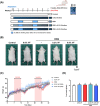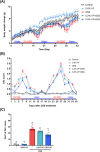Virofree Associates with the Modulation of Gut Microbiomes and Alleviation of DSS-Induced IBD Symptoms in Mice
- PMID: 37969979
- PMCID: PMC10633932
- DOI: 10.1021/acsomega.3c05159
Virofree Associates with the Modulation of Gut Microbiomes and Alleviation of DSS-Induced IBD Symptoms in Mice
Abstract
Inflammatory bowel disease (IBD) is a chronic, nonspecific inflammation of the intestines that primarily comprises Crohn's disease and ulcerative colitis. The incidence and prevalence of IBD have been increasing globally, highlighting the significance of research and prophylactic interventions. Virofree, a mixture of various botanical extracts (including grapes, cherries, olive leaves, marigolds, green tea, and others), has shown significant potential in disease prevention. This study examined the effects of Virofree on intestinal inflammation and the gut microbiota in mice using a dextran sulfate sodium (DSS)-induced model. The mice showed no adverse reactions when administered Virofree. Virofree administration reduced the disease activity index as indicated by amelioration of DSS-induced symptoms in the mice, including weight loss, diarrhea, and rectal bleeding. Regarding the gut microbiota, Virofree intervention modulated the DSS-induced decrease in gut microbial diversity; the Virofree group showed no increase in the phyla Proteobacteria or Verrucomicrobia while displaying an increase in the genus Duncaniella, bacteria that may have protective properties. These findings suggest that Virofree may have a direct or indirect impact on the composition of the gut microbiota and that it can alleviate the imbalance of the microbiome and intestinal inflammation caused by DSS treatment.
© 2023 The Authors. Published by American Chemical Society.
Conflict of interest statement
The authors declare no competing financial interest.
Figures








References
LinkOut - more resources
Full Text Sources

